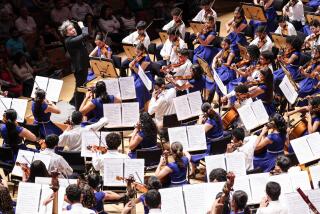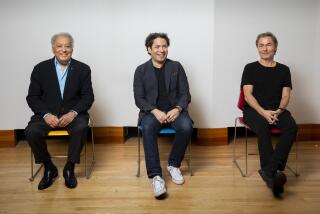MUSIC / DANCE : Tchaikovsky, the Children’s Teacher
Little wonder that so many children discover classical music through Tchaikovsky’s perennial Christmas favorite, “Nutcracker,” either by watching a performance of the ballet or by hearing the famous Suite of music drawn from it. Right from the start, Tchaikovsky creates a world of sound that children can relate to, and that draws them in.
The music can, of course, appeal to adults as well. But it’s the kids who may be learning for the first time how music can create atmosphere, portray character and describe action.
In terms of inventing orchestral sounds for such purposes, lots of composers are indebted to Tchaikovsky. Few have scored music better, or even as well.
“Nutcracker’s” Overture begins with small, quiet, skipping sounds placed in a high range that are easy on young ears; the March, heard soon after, is also placed in this range, scored in the same light way and is full of strong, gently enveloping rhythms.
Tchaikovsky reserves different kinds of sound for different characters. As the plot thickens (when the mysterious Drosselmayer gives the Nutcracker doll to his favorite goddaughter, Clara, triggering the events of the story), Tchaikovsky leaves the light, high sounds behind and begins to draw on the lower, more ominous sounds of the bassoons, trombones and tuba.
He brings the two worlds together when the Nutcracker Prince (depicted by flutes and clarinets) battles the mice (conveyed by the lower winds and brass). Naturally, good wins, and in Act II the Prince takes Clara to the fantasy Land of Sweets, as Tchaikovsky spins one of those broad, lovely, romantic themes that he never seemed to run out of.
He also begins experimenting with new kinds of sounds for special, ravishing effect. Right before the curtain goes up, he has flutes flutter-trill chords, creating a sound picture of a cascading fountain (which is what the audience actually saw at the ballet’s premiere in December, 1892).
He also experiments in the Sugar Plum Fairy’s Variation, introducing an instrument his Russian audience had never heard before--the celesta, a metal keyboard that creates the delicate tones he deemed appropriate to this fantastic figure.
(Tchaikovsky had heard the celesta in Paris and had it sent secretly to St. Petersburg for the premiere. “I would prefer it to be shown to nobody,” he wrote to a friend, “for I am afraid that Rimsky-Korsakov and Glazunov will get wind of it and use its unusual effects sooner than me.”)
For those who know only the 20-minute “Nutcracker” Suite, the complete ballet can be a joyful discovery. One realizes that Tchaikovsky did not necessarily draw the best music from the ballet.
‘Nutcrackers’
Ballet Pacifica’s staging continues through Sunday, Dec. 23, at Laguna Playhouse, 606 Laguna Canyon Road, Laguna Beach. Daily at 3:30 and 7:30 p.m. Tickets: $12, $10 for seniors and children under 12. (714) 642-9275.
Robert Joffrey’s 19th-Century American staging continues through Dec. 30 at the Los Angeles Music Center. Thursdays through Saturdays at 2 and 8 p.m., Sundays at 2 p.m. and Wednesday, Dec. 26, at 8 p.m. Tickets: $8 to $45. (213) 480-3232.
Former Bolshoi members Alla Khanashvili-Artyushkina and Vitaly Artushkin join the Long Beach Ballet through Sunday, Dec. 23, at the Terrace Theater, 300 E. Ocean Blvd., Long Beach. Daily at 8 p.m. with Saturday and Sunday matinees at 2. Tickets: $11 to $28 (half price for children under 12). (213) 427-5206.
More to Read
The biggest entertainment stories
Get our big stories about Hollywood, film, television, music, arts, culture and more right in your inbox as soon as they publish.
You may occasionally receive promotional content from the Los Angeles Times.










